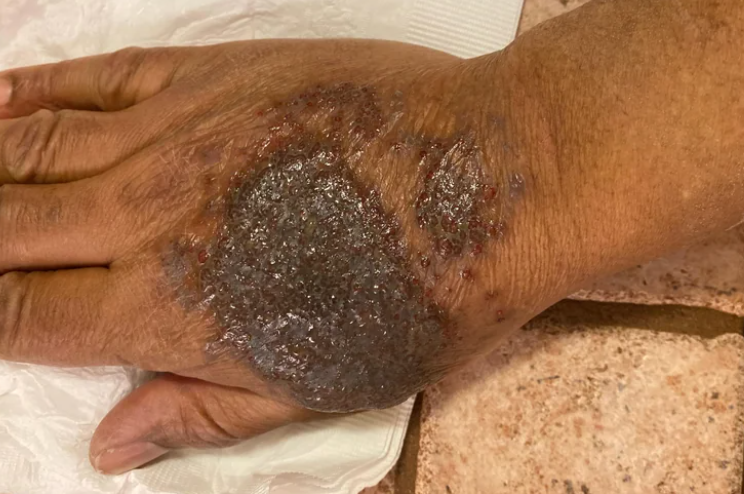Acroangiodermatitis (Pseudo-Kaposi sarcoma, Stewart-Bluefarb syndrome) is a benign vascular hyperplasia resulting from a localized circulatory disorder in the lower extremities that resembles Kaposi sarcoma. ICD-10 Code: I78.9.
Acroangiodermatitis occurs most commonly in males aged 40-50 years and is associated with chronic venous insufficiency in the superficial and deep venous systems of the lower extremities, primarily the feet. The pathophysiology is unclear. Some studies suggest an increase in angiogenic growth factors following disruption of normal cutaneous vascular perfusion. Some authors consider acroangiodermatitis to be a clinical variant of stasis eczema. Stewart-Bluefarb syndrome is observed in children and adolescents and is associated with venous insufficiency due to congenital arteriovenous fistulas.Acroangiodermatitis
It is characterized by the appearance of patches and papules of red, brown, purple and violet color on the dorsal surface of the feet, ankles, shins, extensor surface of the 2nd and 3rd toes around the metatarsophalangeal joint, interdigital spaces, gradually transforming into plaques with irregular borders and nodules. The rash elements often occur against the background of hyperpigmented areas of the skin, resembling Favre-Racouchot syndrome. In some cases, the appearance of a yellow-brown pigmented patch, infiltrated at the base, with clear borders may be the first sign of the disease.
The surface is often crusted and ulcerations are observed in areas prone to mechanical trauma. Patients may experience itching, burning, and pain in the affected areas. Symmetrical involvement is more common, but in some cases it may be unilateral. In most cases, there is enlargement of the subcutaneous veins and edema in the affected limb.
Stewart-Bluefarb syndrome
It manifests as patches or papular-plaque elements of bluish-red or purplish-brown color, sometimes with ulceration and tenderness. It is always unilateral. It is often associated with thickening of the lower extremities with signs of local hyperthermia and hyperhidrosis. Occasionally, dilated veins and pulsation may be observed on the surface of the affected areas.
- Kaposi sarcoma associated with AIDS
- Kaposi sarcoma not associated with AIDS
- Bacillary angiomatosis
- Reactive angioendotheliomatosis
- Stasis dermatitis (eczema)
- Capillaritis, including Schamberg's disease and pigmented purpuric dermatitis
- Vasculitis
- Traumatic purpura
- Lichen planus and lichen simplex chronicus
- Atrophie blanche
- Lipodermatosclerosis
- Arterial or venous ulcers
- Angiosarcoma
- Hemangioendothelioma
- Hemangioma
Acroangiodermatitis.
There is no effective treatment. Treatment focuses on management of chronic venous insufficiency, including compression therapy. Some studies have shown improvement with the use of oral antibiotics such as erythromycin or clindamycin.
Treatment:- Erythromycin 500 mg four times a day for 12 weeks or
- Erythromycin 500 mg twice a day for 6 weeks, then 250 mg twice a day for 6 weeks or
- Erythromycin 500 mg four times a day for 3 weeks
- Azithromycin 500 mg once a day for 12 weeks
- Amoxiclav 1 g twice a day for 2 weeks
- Ciprofloxacin 500 mg twice a day for 2 weeks
- Clindamycin 600 mg three times a day for 2 weeks
- Doxycycline 100 mg twice a day for 15 days
- Calcium dobesilate 500 mg twice a day for 3 weeks
- Dapsone 50 mg twice a day for 12 weeks
- Clobetasol propionate (0.05%) cream Apply twice a day for 15 days
Stewart-Bluefarb syndrome
Conservative treatment includes tight bandaging and topical corticosteroids. Surgical treatment involves ligation or excision of the arteriovenous fistula.

